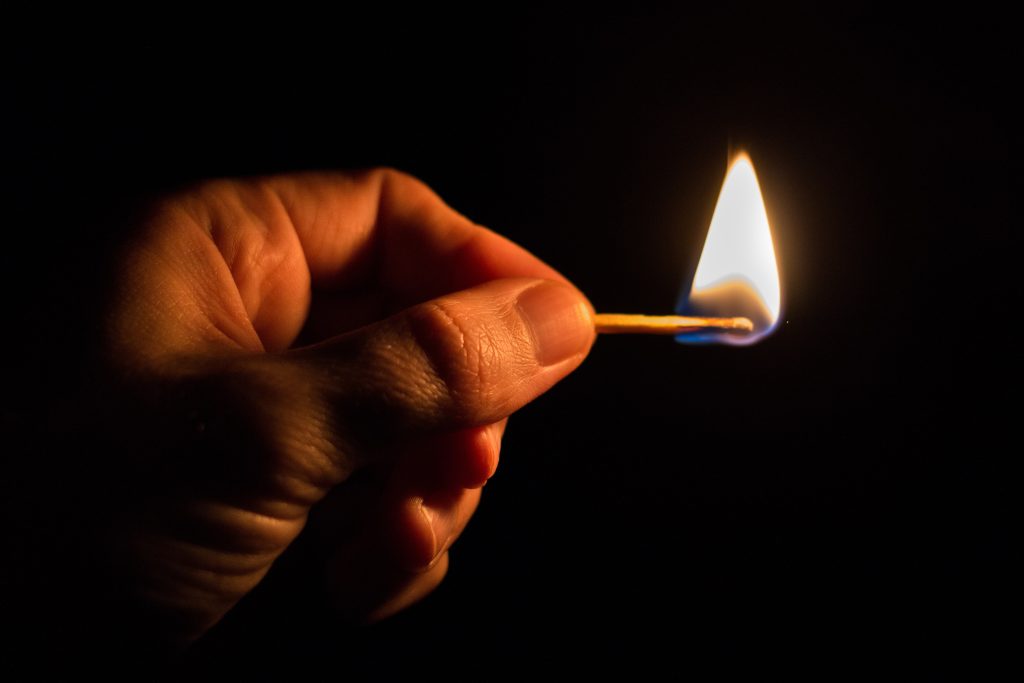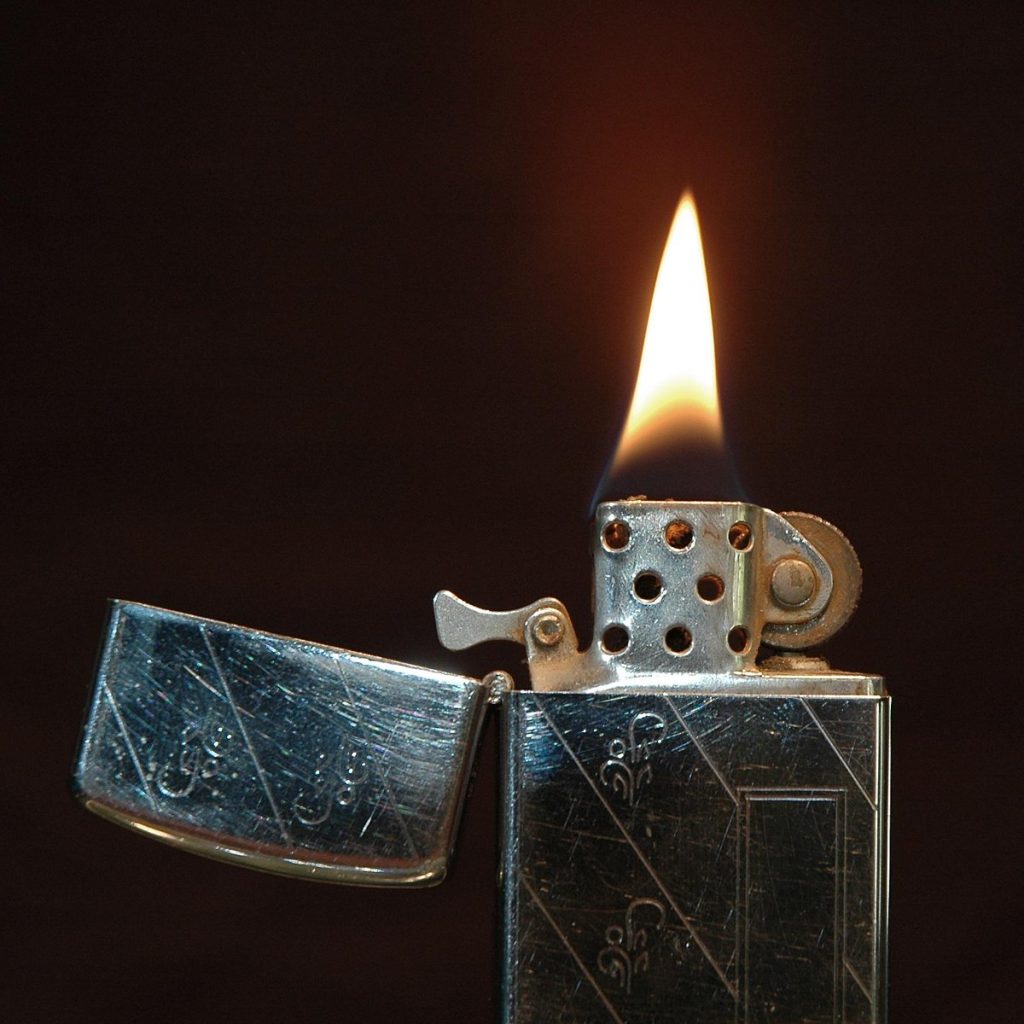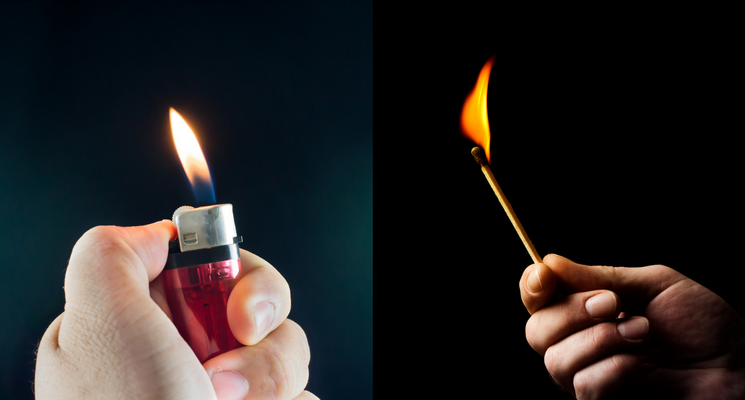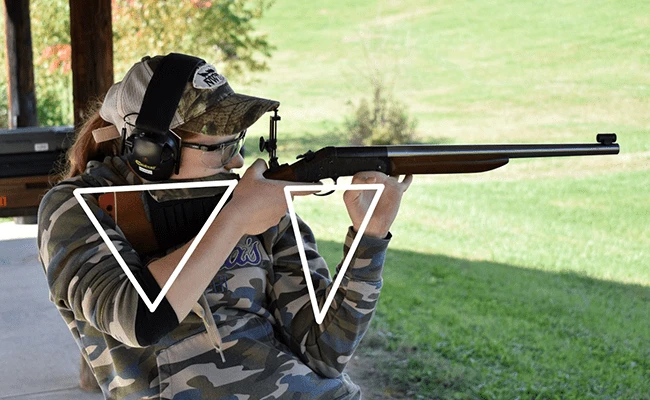Yes, the lighter was invented before the match. The first lighter, known as the “Pyrophoros,” was created by Johann Wolfgang Döbereiner, a German chemist, in 1823.
It used a chemical reaction involving hydrogen gas to produce a flame when a trigger was pressed.
On the other hand, the modern friction match, which we commonly use today, was invented later by John Walker, an English chemist, in 1827.
Walker’s invention allowed people to strike a match against a rough surface to create a flame.
So, the invention of the lighter predates the invention of the match by a few years.
The Invention of the Match A. Early attempts to create fire-starting devices

The invention of the match represents a significant milestone in the history of fire-starting technology. Before the advent of matches, people relied on various methods to ignite fires, often involving cumbersome and time-consuming processes.
Early attempts to create fire-starting devices included the use of flint and steel, which involved striking steel against flint to create sparks that could ignite a piece of tinder. This method was effective but required skill and was not very convenient.
The development of the friction match
The real breakthrough in fire-starting technology came with the development of the friction match in the early 19th century.
The friction match, often referred to as the “strike-anywhere” match, was a small, portable device that could easily ignite a fire. It consisted of a small wooden stick or splint with a tip coated in a mixture of chemicals that could be ignited through friction.
To use the match, an individual simply had to strike the tip against a rough surface to create the necessary friction and generate a flame.
This innovation revolutionized the way people started fires, making the process more convenient and accessible.
John Walker and his contribution
The credit for the invention of the friction match is often attributed to an English chemist named John Walker. in 1826 Walker accidentally discovered the match while mixing chemicals in his laboratory.
He had coated a stick with a mixture of antimony sulfide, potassium chlorate, gum arabic, and starch. To his surprise, he found that the stick could be ignited by scraping it across the hearth of his fireplace.
Recognizing the potential of his accidental discovery, Walker began producing and selling these “sulfur-tipped” matches, which quickly gained popularity.
John Walker’s contribution to the development of the friction match laid the foundation for the match industry’s growth and further innovations in fire-starting technology.
His invention significantly improved the ease and convenience of starting fires, which had a profound impact on various industries, including cooking, lighting, and heating, and contributed to the advancement of everyday life during the 19th century and beyond.
The Birth of the Lighter A. The origins of the first lighter
The birth of the lighter as a portable fire-starting device has a fascinating history. Before the invention of lighters, people relied on matches, flint steel, or other methods to ignite fires.
The concept of a portable device for creating fire on demand marked a significant innovation.
Johann Wolfgang Döbereiner and the “Pyrophoros”
One of the early pioneers in the development of the lighter was the German chemist Johann Wolfgang Döbereiner.
In the early 19th century, Döbereiner invented a device known as the “Pyrophoros” or “Döbereiner’s lamp.” This device was based on a chemical reaction that activated a flame.
How the chemical reaction-based lighter worked
Döbereiner’s Pyrophoros was a simple yet ingenious device. It consisted of three main components:
- Hydrogen gas: Inside the Pyrophoros, hydrogen gas is produced through the reaction of a solid chemical, usually zinc, with sulfuric acid.
- A porous ceramic or platinum sponge: This material acted as a catalyst, facilitating the reaction between the hydrogen gas and oxygen in the air.
- A flint wheel: To ignite the Pyrophorus, a flint wheel was used. When the user spun the wheel, a spark ignited the hydrogen gas, producing a flame.
The Pyrophoros was a significant improvement over traditional methods of fire-starting. It was portable, reliable, and capable of producing a consistent flame.
This made it a valuable tool for a variety of applications, including lighting lamps and stoves. However, it had some limitations, such as the need to replenish the hydrogen gas supply periodically.
Chronological Comparison
A side-by-side timeline of the match and lighter invention
1823: Invention of the Lighter
Johann Wolfgang Döbereiner invented the “Pyrophoros” or “Döbereiner’s lamp,” a chemical reaction-based lighter that produces fire when activated through a spark created by a flint wheel.
1827: Invention of the Match
English chemist John Walker accidentally discovered the friction match, a small wooden stick with a chemical-coated tip that can be ignited through friction against a rough surface, revolutionizing fire-starting technology.
The matches invented in 1827 and the lighter in 1823
In 1827, the match was invented by John Walker, introducing a portable and convenient method of starting fires.
This invention marked a significant advancement in fire-starting technology, allowing people to create fire on demand with a simple and easily transportable device.
On the other hand, in 1823, Johann Wolfgang Döbereiner developed the “Pyrophoros” or “Döbereiner’s lamp,” which was one of the early iterations of lighters.
This chemical reaction-based device utilized hydrogen gas and a flint wheel to produce a flame. While it represented a remarkable innovation in fire-starting, it was not as widely adopted as the friction match.
These inventions were crucial in the history of fire-starting devices. The match became widely popular because of its simplicity and portability, while the lighter set the stage for more advancements in fire-starting technology.
Early Uses and Adoption
How matches and lighters were initially used
Matches and lighters, upon their respective inventions, served distinct purposes and found their places in everyday life:
Matches:
With their easy ignition mechanism, matches were initially used primarily for lighting lamps, candles, and stoves. They made these daily tasks much more convenient compared to traditional methods, such as flint and steel.
Matchsticks were also used for personal lighting needs, offering a portable way for individuals to create fire whenever required, like in outdoor activities or for smoking.
Lighters:
Like Johann Wolfgang Döbereiner’s “Pyrophoros,” early lighters were primarily used for lighting lamps, stoves, and other devices that required a controlled flame.
These chemical reaction-based lighters were especially useful in situations where a reliable source of fire was needed but not readily available, such as in scientific experiments or industrial processes.
The impact on daily life and technology of the time
The introduction of matches and lighters had a profound impact on daily life and technology during the 19th century:
Matches:
The invention of the match in 1827 by John Walker greatly simplified the process of creating fire. This innovation had a significant impact on household lighting and heating, reducing reliance on less convenient methods like flint and steel.
Matches led to the development of safety matches, which featured a separate striking surface that minimized accidental ignitions, making them even safer and more accessible for everyday use.
Lighters:
Johann Wolfgang Döbereiner’s “Pyrophoros” and other early lighters provided a more reliable and controlled source of fire, which was crucial for various industrial and scientific applications.
These lighters were used in laboratories, chemical experiments, and other processes that required a controlled flame.
The principle of chemical reaction-based lighters paved the way for subsequent innovations in lighter technology, eventually leading to the familiar pocket-sized lighters that we use today.
Overall, both matches and lighters improved the convenience, safety, and accessibility of fire-starting, impacting various aspects of daily life.
The technology and principles behind these inventions have continued to evolve, making them integral parts of modern society for lighting, heating, cooking, and various other applications.
Advancements and Innovations
Evolutions in match and lighter technology
Over the years, both matches and lighters have seen significant technological advancements and innovations:
Advancements in Matches:
- Safety Matches: The introduction of safety matches in the mid-19th century made a considerable difference. Unlike earlier matches, safety matches required a specific striking surface to ignite, reducing the risk of accidental fires.
- Waterproof Matches: Innovations in match composition led to the creation of waterproof matches, which are treated to resist moisture. These matches are ideal for outdoor activities and emergency situations.
- Strike-Anywhere Matches: While safety matches became prevalent, “strike-anywhere” matches that did not require a specific striking surface continued to be used by those who needed maximum convenience.
Advancements in Lighters:
- Gas Lighters: The evolution of lighters progressed with the introduction of gas lighters, which utilized pressurized gas as a fuel source. These lighters were refillable and allowed for adjustable flames.
- Electric Lighters: Modern electric lighters, which use electricity to generate a plasma arc or heating element, have gained popularity in recent years. These lighters are rechargeable and do not rely on fuel.
- Specialty Lighters: There are now specialty lighters designed for specific applications, such as cigar lighters with precise control over the flame size and torch lighters for various purposes.
Notable inventors and their contributions
Several inventors and innovations have played a role in the development of matches and lighters:
Matches:
- Gustaf Erik Pasch: The Swedish chemist who invented safety matches in 1844, introducing a safer way to ignite matches without the risk of accidental fires.
- Joshua Pusey: The American inventor who patented the first friction matchbook in 1892, making matches even more convenient and portable.
Lighters:
- Ignacy Łukasiewicz: The Polish inventor who developed an early version of the lighter using a self-igniting candle and a chemical reaction in the mid-19th century.
- Ronson and Zippo: The Ronson Company and Zippo Manufacturing Company have been significant players in the development of modern lighters.
Ronson introduced the first pocket lighter in the early 20th century, while Zippo popularized the iconic flip-top, windproof lighter design.
The transition from early designs to modern versions
Both matches and lighters have transformed remarkably from their early designs to the modern versions we are familiar with today.
Improvements in safety, convenience, and versatility have characterized these transitions:
- Safety Features: Both matches and lighters have seen the incorporation of safety features to prevent accidents and ensure controlled ignition.
- Portability: Matchboxes and pocket-sized lighters have made these fire-starting devices highly portable, allowing people to carry them conveniently in their pockets or bags.
- Fuel Sources: Innovations in fuel sources, including the shift from chemical mixtures to gas and electricity, have made lighters more efficient and environmentally friendly.
- Refillable and Rechargeable: Modern lighters are often designed to be refillable or rechargeable, reducing waste and ensuring longevity.
- Specialized Designs: There is a wide range of specialized matches and lighters designed for specific applications, such as outdoor use, smoking, and hobbies.
The advancements in match and lighter technology have made these devices safer and more convenient and reflective of changing societal needs and values.
Modern Uses and Variations

Contemporary uses of matches and lighters
In today’s world, matches and lighters still have many practical uses and have even found new applications:
- Emergency Preparedness: Matches and lighters are essential items in emergency preparedness kits. They provide a reliable source of fire during power outages, natural disasters, and outdoor survival situations.
- Camping and Outdoor Activities: Both matches and lighters are indispensable tools for campers and outdoor enthusiasts. They are used for starting campfires, lighting stoves, and providing a source of heat and light in the wilderness.
- Smoking Culture: Lighters, in particular, remain closely associated with smoking culture. Whether for lighting cigarettes, cigars, or pipes, lighters continue to play a significant role in the smoking experience.
- Culinary Use: Matches and lighters are used in the culinary world for searing and torching dishes and lighting gas stoves and ovens.
Culinary torches, which use butane as fuel, have gained popularity for precision cooking techniques.
The role of lighters in outdoor activities and smoking culture
Lighters, in particular, have become integral to various aspects of modern life:
- Outdoor Activities: Lighters are essential for outdoor enthusiasts, campers, hikers, and adventurers who rely on them for fire-starting, cooking, and providing warmth in remote settings.
The convenience and reliability of lighters make them a preferred choice for outdoor activities.
- Smoking Culture: Lighters are deeply ingrained in smoking culture, from lighting up cigarettes and cigars to ceremonial uses in traditional rituals. They come in a variety of designs and styles, catering to individual preferences and aesthetics.
- Collectibles: Lighters have become collectible items, with enthusiasts seeking vintage and unique designs. Brands like Zippo and Ronson have produced limited-edition lighters, further enhancing their appeal as collectibles.
Collectibles and nostalgia for vintage versions
Both matches and lighters, especially when they feature distinctive designs or branding, have gained recognition as collectibles.
Collectors often seek vintage versions, unique packaging, and limited-edition releases. The appeal of these collectibles lies in their historical and aesthetic value, as well as the nostalgia they evoke:
- Vintage Lighters: Vintage lighters, such as Zippo lighters from past decades, are sought after by collectors. They often feature unique engravings, artwork, or historical references, making them valuable for collectors and enthusiasts.
- Matchbook Collecting: Matchbook collecting, also known as phillumeny, is a hobby where collectors seek out matchbooks with interesting designs, advertising, or historical significance.
Matchbooks offer a window into the past, showcasing cultural trends and advertising of bygone eras.
- Nostalgia: Matches and lighters can evoke feelings of nostalgia, reminding people of times when they were more commonly used for everyday tasks.
Collectors often appreciate the historical and sentimental value associated with these fire-starting devices.
In the digital age, where fire-starting methods have become more automated and electronic, matches and lighters maintain their appeal as tangible tools with a rich history.
They continue to find relevance in various facets of modern life, from outdoor adventures and cooking to treasured collectibles for enthusiasts who appreciate their enduring charm and utility.
FAQs
Was the lighter invented before the match?
No, the match was invented before the lighter.
Who invented the match, and when?
The match was invented by John Walker, an English chemist, in 1827.
Who invented the first lighter, and when?
The first lighter was invented by Johann Wolfgang Döbereiner, a German chemist, in 1823.
What type of match did John Walker invent?
John Walker invented the friction match, which could be ignited by striking it against a rough surface.
How did Döbereiner’s lighter work?
Döbereiner’s lighter, known as the “Pyrophoros,” operated using a chemical reaction involving hydrogen gas to produce a flame when a trigger was pressed.
Did the invention of the lighter inspire the creation of matches?
No, the invention of the lighter and the match were separate developments with different mechanisms.
What were the early uses of matches and lighters?
Early matches and lighters were primarily used for fire-starting and lighting purposes in daily life.
How have matches and lighters evolved over time?
Both matches and lighters have seen advancements in technology and design, leading to modern variations for various applications.
What is the significance of matches and lighters in society?
Matches and lighters have played a crucial role in convenience, safety, and industry, impacting daily life and technology.
Are there safety regulations for matches and lighters?
Yes, safety regulations and standards govern the production and use of both matches and lighters to ensure their safe operation.
Can you still find vintage versions of matches and lighters?
Yes, vintage matches and lighters are often collected as memorabilia, and
Conclusion
In conclusion, matches and lighters, two seemingly simple yet highly practical inventions, have left an indelible mark on the way we create fire and carry it with us.
Their historical significance and modern adaptations continue to play a vital role in society today.
Matches, with their convenient and portable design, have improved everyday tasks like lighting stoves and candles and have also found applications in emergency preparedness and outdoor adventures.
Meanwhile, lighters, particularly in the context of outdoor activities and smoking culture, remain indispensable tools, offering reliability and ease of use.











